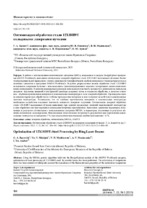| dc.contributor.author | Баевич, Г. А. | |
| dc.contributor.author | Никитюк, Ю. В. | |
| dc.contributor.author | Мышковец, В. Н. | |
| dc.contributor.author | Максименко, А. В. | |
| dc.contributor.author | Аушев, И. Ю. | |
| dc.coverage.spatial | Минск | ru |
| dc.date.accessioned | 2023-06-12T10:33:52Z | |
| dc.date.available | 2023-06-12T10:33:52Z | |
| dc.date.issued | 2023 | |
| dc.identifier.citation | Оптимизация обработки стали 12Х18Н9Т кольцевыми лазерными пучками = Optimization of 12Х18Н9Т-Steel Processing by Ring Laser Beams / Г. А. Баевич [и др.] // Наука и техника. – 2023. – № 3. – С. 186-192. | ru |
| dc.identifier.uri | https://rep.bntu.by/handle/data/129582 | |
| dc.description.abstract | В работе с использованием генетического алгоритма MOGA, встроенного в модуль DesignXplorer программы ANSYS Workbench, выполнена оптимизация лазерной обработки стали 12Х18Н9Т кольцевыми пучками. Расчет температурных полей проводили с учетом зависимости теплофизических свойств материала от температуры методом конечных элементов в программе ANSYS Workbench. Получена регрессионная модель обработки стали 12Х18Н9Т кольцевыми лазерными пучками с использованием гранецентрированного варианта центрального композиционного плана эксперимента. В качестве варьируемых факторов использовали плотность мощности и длительность импульсов лазерного излучения, внешний и внутренний диаметры лазерного пучка в плоскости обработки, в качестве откликов – глубины проплавления материала и максимальные температуры в зоне лазерной обработки. Произведена оценка влияния параметров обработки на глубины проплавления материала в зоне лазерного воздействия и максимальные значения температуры. Установлено, что на глубины проплавления материала и максимальные температуры наибольшее воздействие оказывает плотность мощности лазерного излучения. Оптимизацию лазерной обработки стали 12Х18Н9Т кольцевыми пучками выполняли при задании предельных значений максимальной температуры в зоне обработки для трех вариантов минимальной глубины проплавления. Выполнено сравнение параметров, полученных в результате оптимизации с использованием алгоритма MOGA, и параметров, полученных в результате конечно-элементного моделирования. Максимальная относительная погрешность результатов при определении максимальных температур не превысила 1 %, при определении максимальных глубин проплавления – 6 %. | ru |
| dc.language.iso | ru | ru |
| dc.publisher | БНТУ | ru |
| dc.title | Оптимизация обработки стали 12Х18Н9Т кольцевыми лазерными пучками | ru |
| dc.title.alternative | Optimization of 12Х18Н9Т-Steel Processing by Ring Laser Beams | ru |
| dc.type | Article | ru |
| dc.identifier.doi | 10.21122/2227-1031-2023-22-3-186-192 | |
| local.description.annotation | Using the MOGA genetic algorithm built into the DesignXplorer module of the ANSYS Workbench program, optimization of laser processing of 12Х18Н9Т-steel by annular beams has been performed. The calculation of temperature fields has been carried out taking into account the dependence of the thermophysical properties of the material on temperature by the finite element method in the ANSYS Workbench program. A regression model has been obtained for processing 12Х18Н9Т-steel by annular laser beams using a face-centered variant of the central compositional plan of the experiment. The power density and duration of laser radiation pulses, the outer and inner diameters of the laser beam in the processing plane were used as variable factors. The penetration depths of the material and the maximum temperatures in the laser processing zone were used as responses. The influence of processing parameters on the penetration depths of the material in the laser impact zone and the maximum temperature values has been evaluated. It has been established that the depth of penetration of the material and the maximum temperatures are most affected by the power density of laser radiation. Optimization of laser processing of 12Х18Н9Т-steel by annular beams was carried out by setting the limiting values of the maximum temperature in the processing zone for three variants of the minimum penetration depth. The parameters obtained as a result of optimization using the MOGA algorithm and the parameters obtained as a result of finite element modeling are compared. The maximum relative error of the results when determining the maximum temperatures did not exceed 1 % and when determining the maximum penetration depths did not exceed 6 %. | ru |

